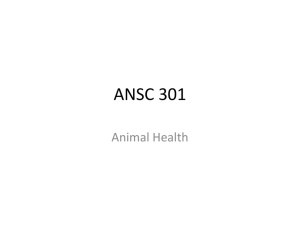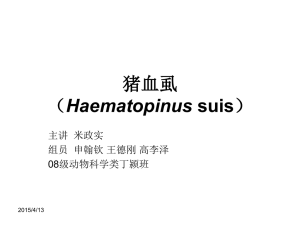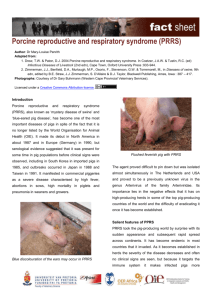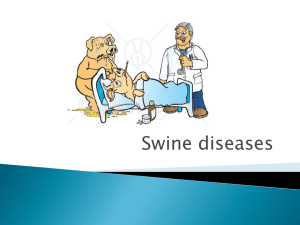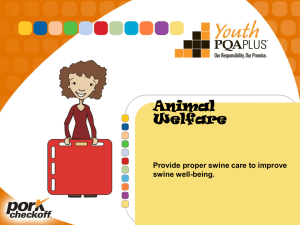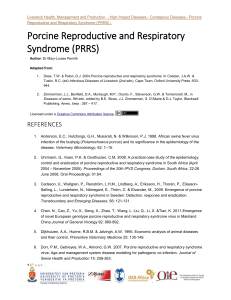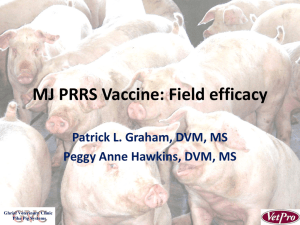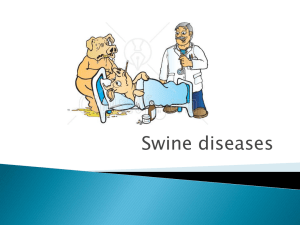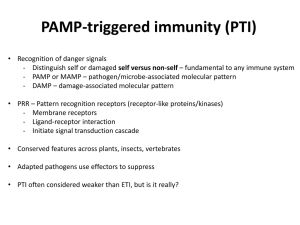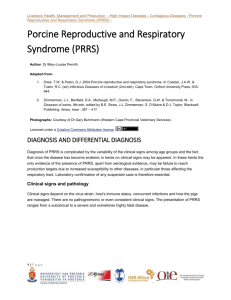Swine Diseases 2012
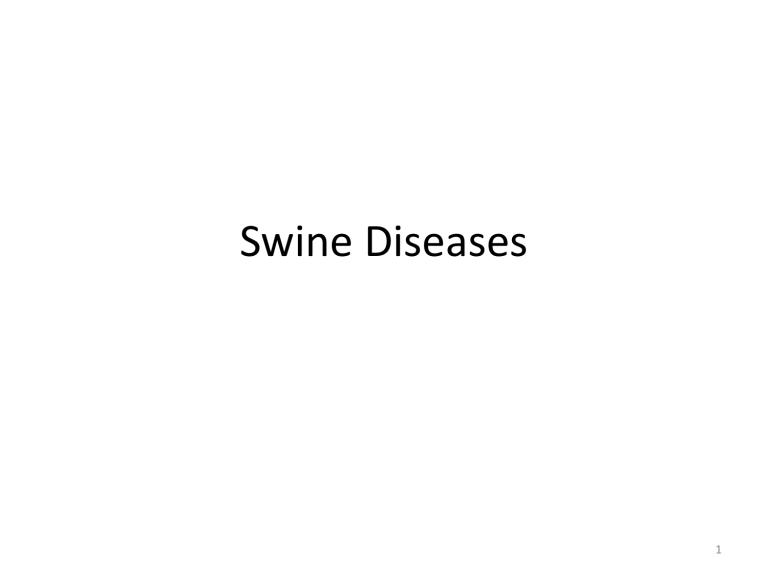
Swine Diseases
1
Current Health Challenges and
Solutions
John Waddell, DVM, MBA
Swine Veterinarian
2
Sources of Information on Swine
Health
• Diseases of Swine, 9 th ed., 2006; Straw, B., et.al.
• American Association of Swine Veterinarians
– Journal of Swine Health and Production
– AASV.org website; disease modules
– Swine Disease Manual, 4rd edition 2009;
Neumann, Ramirez, Schwartz
– Annual meeting proceedings, 2000-11
– www.AASV.org
3
Importance of Health to Performance
• Of the primary factors that affect throughput, efficiency, variation and productivity, health is the most important.
• With health challenges:
– genetic potential will not be expressed
– the best nutrition formulation or ration will not produce top results
– the best management will not shine
– the perfect environment will not allow for great production
4
Health Challenges Outline
• Respiratory challenges
• “Suis-cide” challenges
• Enteric challenges
• Other health challenges
• Solutions for health challenges
5
Respiratory
• Porcine Respiratory Disease Complex (PRCD)
• Viral agents
– Porcine Respiratory and Reproductive Syndrome
(PRRS virus)
– Swine Influenza Virus (SIV)
• Mycoplasma hyopneumoniae
• Bacterial agents
– Pasteurella sp.
– Actinobacillus pleuropneumonia (App)
6
Porcine Respiratory Disease
Complex (PRDC)
• Just as the name implies…respiratory problems in growing pigs are nearly always a result of multiple bugs and insults
• A “mixed” infection
• Outside of the lab, rarely is respiratory disease the result of a single pathogen!
• Any type of stress can be the first insult that leads to a cascade of events that can end up with disease and death
7
PRDC
• PRRS, SIV and Mycoplasma act as “door openers”
• Secondary bacteria such as Pasteurella sp. take advantage of the lowered defense mechanisms due to the “door openers”
• The lungs become more susceptible to the secondary invaders after becoming infected with virus or mycoplasma
• Generally, one pathogen intensifies the other
8
Components of PRDC
• Viral
– PRRS, SIV, and PCV2
• Bacterial
– Mycoplasma hyopneumoniae
– Pasteurella multocida
– Strep. suis
– Haemophilus parasuis
– Actinobacillus pleuropneumoniae
– Actinobacillus suis
– Salmonella choleraesuis
9
Clinical Signs
• Fever
• Anorexia
• Lethargy
• Coughing
• Gauntness
• Labored breathing
“Thumping”
10
11
PRRS Virus
• Remains the number one “co-factor” for swine respiratory disease complex
• Research shows that PRRS virus costs swine producers hundreds of millions of dollars per year
• It has been estimated that 70% of the cost of a
PRRS break can be attributed to the postweaning phase of production
12
PRRS Virus
• Recent research has demonstrated aerosol transmission of infectious PRRS virus for nearly 3 miles
• Some veterinarians believe we must control the respiratory form of PRRS in the growing pig before we hope to gain area control
• Several production systems are immunizing pigs with the commercial PRRS MLV vaccine for control and reduction of virus in areas of concentrated swine production
13
PRRS Virus Lung Lesions
Low Virulence
High Virulence
Source: Dr. Pat Halbur, Iowa State University
14
PRRS Virus
• Many boar studs and recently, some sow sites have installed air filtration equipment to prevent the introduction of aerosolized PRRS virus and other pathogens
15
PRRS Virus
• “Rope” technology is being developed and tested for
PRRS virus monitoring of populations
16
Swine Influenza Virus (Flu)
• Flu is a common viral co-factor in PRDC
• Until circa 1998, we dealt exclusively with the
“classic swine flu” in pigs, a strain called H1N1
• In the late 90’s, a different strain, H3N2 began infecting swine, particularly sows.
• H1N1 tended to be a seasonal problem in growing pigs causing transient anorexia, fever and coughing
• H3N2 has become more of an endemic virus
17
Swine Flu
• Sow vaccination is common (either pre-farrow or twice a year to the entire herd)
• Autogenous vaccine is also common in attempt to keep up with the drift and changes in the virus
• SIV is an RNA virus (same type as PRRS) which means it changes frequently making it difficult to control with today’s vaccine technology
• Swine flu can be zoonotic so worker vaccination is important
18
Acute Swine Influenza (SIV)
• High morbidity and low mortality
• Fever: 105 + degrees F
• Off feed and depressed
• Labored abdominal breathing
• Nasal discharge
• Deep barking cough
• Pigs may be unable to rise
19
They don’t always cough!
Source: Dr. Marie Gramer, University of Minnesota
20
SIV Clinical Signs
•
Depends on age and immune
status of the affected pigs
•
May vary depending on strain of SIV involved
•
Rapid recovery in 3-7 days if infection is uncomplicated
21
Swine Influenza Virus Infection Timeline
Exposure
Peak
Fever
Peak Virus
Excretion
Sample
Collection
Viral
Clearance
Seroconversion
24 h 48 h
Coughing ~ 2 weeks
192 h
(~1 wk)
240 – 336 h
(10 – 14 days)
Dr. Mike Senn
Source: Dr. Marie Gramer, University of Minnesota
22
Swine Influenza (SIV)
Typical Lung Lesions
23
Maternal Antibody
“Passive Immunity”
• Passive antibody from the sow is generally protective
• Can last up to 8-12 weeks of age
• Passive immunity decay explains
SIV-induced disease is most common in pigs older than 12 weeks of age
24
Mycoplasma
• Mycoplasma hyopneumoniae is nearly ubiquitous in pig populations in the U.S.
• While elimination attempts are usually successful in sow populations, re-infection of the pigs in swine-dense areas make vaccination a necessary part of most commercial herds
• Mycoplasma spreads among the populations of growing pigs acting as a “door opener” for secondary bacteria
25
Mycoplasma Pathogenesis
• Incubation period: 10 - 16 days
• Considerable variability in duration
• Onset of disease dependent on intensity of infection (exposure rate)
• Disease is not evident in most pigs until 3-6 months of age
• Vaccines are effective at reducing severity of lesions, clinical signs, and affect on performance but do not prevent infection
26
Mycoplasma Clinical Signs
• Described as a chronic disease with
– High morbidity (high infection rate)
– Low mortality (low death rate)
• Chronic, non-productive cough
• Fever, usually low grade
• Gradual onset
• Normal breathing unless severe lung damage or secondarily infected
27
Mycoplasma Lung Lesions
28
Secondary Bacterial Infections
• Pasteurella, Actinobacillus, Haemophilus,
Streptococcus, and Bordetella sps. are often resident in the population
• We have been blessed with some awesome new tools for treatment of bacterial pneumonia but…
• Early identification of sick pigs and treatment is the key to treatment success!
29
Pasteurella multocida, Mycoplasma and PRRS
30
“Suis-cide” Challenges
• Streptococcus suis (Strep suis)
• Hemophilous parasuis (Polyserositis or
“Glasser’s Disease”)
• Actinobacillus suis (A. suis)
• These bugs are present in nearly every population
• Improving management/ reducing environmental stressors are the key to control
31
“Suis-cide” Challenges
• All these bugs can cause “sudden” deaths
• Often mortality and morbidity are higher in “start-up” or repopulated herds.
• Strep suis: CNS, arthritis, or respiratory forms
• H. parasuis: polyserositis
• A. suis: respiratory, skin lesions, arthritis
32
Endocarditis
33
Polyserositis/pericarditis
34
Enteric (gut) Challenges
• Neonatal challenges
– E.coli (K88, F18, 987P)
– Clostridium perfringes type A and C. difficile
– Coccidiosis
– Viral (rotavirus, TGE)
• Nursery phase challenges
– E.coli, Salmonella sp., ileitis, PCS, Viral
• Finishing phase challenges
– HBS, Ileitis, Salmonella sp., Brachyspira, PCV2
35
• Lawsonia intracellularis
• Confirmed in 1993
• Replicates within cytoplasm of epithelial cells of the ileum
Ileitis
36
Ileitis Clinical Signs
• Clinical signs of acute ileitis can vary from a mild, non-hemorrhagic diarrhea to severe, hemorrhagic, watery diarrhea with rapid onset
• Pigs chronically affected display looseness sometimes tinged with blood along with loss of body condition and fail to thrive
• Subclinical form of ileitis has also been identified which affects growth performance
37
38
Lesions of ileitis are variable
Source: Dr. Connie Gebhart, University of Minnesota
39
Where is the ileum ?
40
Solutions for Ileitis
• We have several effective antimicrobials approved for ileitis and when pulse-dosed at critical periods are very effective in control of ileitis
• We also have an approved and effective avirulent live vaccine that can be used to orally vaccinate for ileitis
• Timing and implementation are paramount regardless of the approach you take
41
Porcine Circovirus Associated Disease
(PCVAD)
• First identified and diagnosed in Canada in mid 1990’s as PMWS (Post-weaning Multi-systemic Wasting
Syndrome).
• Became a serious health problem with high mortalities in nursery pigs in UK and Europe in 2001 and beyond.
Called PCVD in Europe
• Emerged in the US in 2005-2006
• Substantial losses across U.S. industry
• Initially called PMWS and associated with PDNS
42
Dr. Mattew Turner
43
PCVAD
• “Race for a cure” yielded three commercially available and efficacious vaccines
• Vaccine has proven itself beyond doubt!
• New discoveries regarding this agent continue
• Subclinical cases are now the focus as it has been found that vaccine in the absence of typical clinical PCVAD, has led to improved
ADG and reduction in the number of light pigs at market time.
44
45
PCVAD can be subclinical or include one or more of the following clinical manifestations:
• Multi-systemic disease with weight loss (formerly known as PMWS)
• High mortality: Doubling of historical mortality rate without introduction of a new known additional pathogen
• Respiratory signs including pneumonia
• Porcine Dermatitis and Nephropathy Syndrome
(PDNS)
• Enteric signs including diarrhea and weight loss
46
PCV2 associated diarrhea is often seen in the group prior to
PCV2-associated PMWS
Brown-red-black diarrhea
PCVAD
47
Porcine Dermatosis/Nephropathy Syndrome
(PDNS)
Skin Discoloration Enlarged, discolored Kidneys
48
Thickened small intestinal mucosa in a case of PCV2associated enteritis
Enlarged mesenteric lymph nodes
PCV2 antigen in the intestine
(abundant goblet cells: red arrow)
49
Dr. Matt Turner
50
Dr. Matt Turner
51
Dr. Matt Turner
Dr. John Waddell
52
Non-Infectious Challenges
• Hemorrhagic Bowel Syndrome (HBS)
• Gastric Ulcers
• Cannibalism
• Hernias
• Kyphosis/Lordosis (hump-back)
53
HBS / Torsion
• Cause is unknown
• Risk Factors
– Feed interruption
– Rapid ingestion of large amounts of feed / water
– “Binge” eating
– Overcrowding
– Limited feeder space
– Genetic susceptibility
54
Gastric Ulcers
• Risk Factors
– Stress
• Crowding
• Fasting
• Mixing
• Ventilation
• Finely ground feed
– Intermittent Feeding
• Delivery / ordering
• Disease
ANY INTERUPTION IN FEED INTAKE !!!!
55
Cannibalism
• Primarily “tail biting”
• “Vices” such as tail and ear biting are generally a result of stressors which make the pigs uncomfortable and restless
• Uniform tail length and pig comfort are essential in addressing these problems
56
Kyphosis/Lordosis
Straw, et. al. 2008
57
Solutions for Health Challenges
•
Prevention
•
Treatment
•
Elimination
58
First, Know Thy Enemy!
• Diagnose! Find out what pathogens are in the population!
• Attempt to sort the wheat from the chaff!
– Which pathogens are primary?
Secondary? Incidental?
– What stressors could be allowing expression?
59
Diagnose!
• Clinical signs
– Respiratory, enteric, lameness, CNS, ADR?
• History
• Morbidity/Mortality
• Response to therapy?
• Fever?
• Laboratory confirmation
60
After the diagnosis
• Estimate the prevalence of the disease.
• Estimate the cost of the disease in mortality, performance and profit
• Determine if there is an effective treatment or immunization tool available
• Calculate a cost:benefit ratio
• Implement the tool
• Assess response
61
Treat
• One the diagnosis has been reached and the decision to treat is made:
• Use the right tool at the right animal at right time, in the right dose in the right route and in the right frequency
• Choosing the correct therapeutic tool is only a fraction of the process
• Implementation of the treatment plan is critical!
62
Prevent
• Choices abound for preventative options:
– Feedback
– Planned exposure
– Avirulent live, attenuated vaccines
– Bacterins or killed virus vaccines
– Autogenous vaccines
– Prophylactic use of therapeutics
• As with other tools, proper implementation is essential to success
63
If you can’t live with it…
• Eliminate it!
• Multiple options exist
– Depopulation/repopulation
– Age segregated rearing
– Medicated early weaning
– Test and remove
– Mass vaccination and unidirectional pig flow
– Load/immunize/close
64
In the end…
• It is always best to keep disease out!
• Biosecurity should be first on the list
• We now have the knowledge to implement herd biosecurity that really works
• The days of the snake oil salesman are over!
65
66
Current Health Challenges and
Solutions
John Waddell, DVM, MBA
Swine Veterinarian
67
